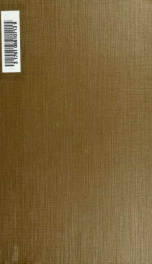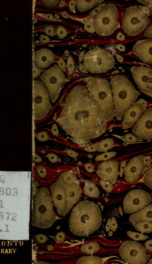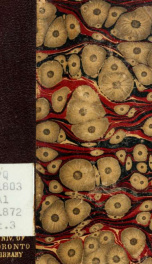theophrastus
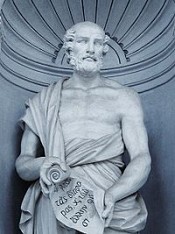
Theophrastus (Greek: Θεόφραστος; c. 371 – c. 287 BC[1]), a Greek native of Eressos in Lesbos, was the successor of Aristotle in the Peripatetic school. He came to Athens at a young age, and initially studied in Plato's school. After Plato's death he attached himself to Aristotle. Aristotle bequeathed to Theophrastus his writings, and designated him as his successor at the Lyceum. Theophrastus presided over the Peripatetic school for thirty-five years, during which time, the school flourished greatly. After his death, the Athenians honoured him with a public funeral. His successor as head of the school was Strato of Lampsacus. The interests of Theophrastus were wide-ranging, extending from biology and physics to ethics and metaphysics. His two surviving botanical works, Enquiry into Plants and On the Causes of Plants, were an important influence on medieval science. There are also surviving works On Moral Characters, On Sensation, On Stones, and fragments on Physics and Metaphysics all written in Greek. In philosophy, he studied grammar and language, and continued Aristotle's work on logic. He also regarded space as the mere arrangement and position of bodies, time as an accident of motion, and motion as a necessary consequence of all activity. In ethics, he regarded happiness as depending on external influences as well as on virtue, and famously said that "life is ruled by fortune, not wisdom." Most of the biographical information we have of Theophrastus was provided by Diogenes Laërtius' Lives of the Philosophers, written four hundred years after Theophrastus' time, though "there is no intrinsic improbability in most of what Diogenes records."[2] He was a native of Eressos in Lesbos.[3] His given name was Tyrtamus (Greek: Τύρταμος), but he later became known by the nickname "Theophrastus", given to him, it is said, by Aristotle to indicate the grace of his conversation (ancient Greek: Θεός = God and φραστος = to phrase i.e divine expression).[4] After receiving his first introduction to philosophy in Lesbos from one Leucippus or Alcippus, he proceeded to Athens, and became a member of the Platonist circle.[5] After Plato's death he attached himself to Aristotle, and in all probability accompanied him to Stagira. The intimate friendship of Theophrastus with Callisthenes,[6] the fellow-pupil of Alexander the Great, the mention made in his will of an estate belonging to him at Stagira,[7] and the repeated notices of the town and its museum in the nine books of his Enquiry into plants and his six books of Causes of Plants point to this conclusion.[8] Aristotle in his will made him guardian of his children, including Nicomachus with whom he was close.[9] Aristotle likewise bequeathed to him his library and the originals of his works,[10] and designated him as his successor at the Lyceum on his own removal to Chalcis.[11] Eudemus of Rhodes also had some claims to this position, and Aristoxenus is said to have resented Aristotle's choice.[8] Theophrastus presided over the Peripatetic school for thirty-five years,[12] and died at the age of eighty-five according to Diogenes.[13] He is said to have remarked "we die just when we are beginning to live".[14] Under his guidance the school flourished greatly— there were at one period more than 2000 students, Diogenes affirms,[15] and at his death, according to the terms of his will preserved by Diogenes, he bequeathed to it his garden with house and colonnades as a permanent seat of instruction. The comic poet Menander was among his pupils.[15] His popularity was shown in the regard paid to him by Philip, Cassander and Ptolemy, and by the complete failure of a charge of impiety brought against him.[16] He was honoured with a public funeral, and "the whole population of Athens, honouring him greatly, followed him to the grave."[17] He was succeeded as head of the Lyceum by Strato of Lampsacus. From the lists of Diogenes Laërtius, giving 227 titles, it appears that the activity of Theophrastus extended over the whole field of contemporary knowledge.[8] His writing probably differed little from Aristotle's treatment of the same themes, though supplementary in details. Like Aristotle, most of his writings are lost works.[8] Thus Theophrastus, like Aristotle, had composed a first and second Analytic.[18] He had also written books on Topics;[19] on the refutation of fallacies;[20] as well as books on the Principles of Natural Philosophy (Physica Auscultatio), on Heaven, and on Meteorological Phenomena.[21] The work of Theophrastus On Affirmation and Denial seems to have corresponded to that of Aristotle's On Judgment. In addition, he wrote on the Warm and the Cold,[6] on Water, Fire,[22] the Sea,[22] on Coagulation and Melting, on various phenomena of organic and spiritual life,[22] and on the Soul and Sensuous Perception.[23] Likewise we find mention of monographs of Theophrastus on the early Greek philosophers Anaximenes, Anaxagoras, Empedocles, Archelaus,[24] Diogenes of Apollonia, Democritus,[25] which were made use of by Simplicius; and also on Xenocrates,[26] against the Academics,[27] and a sketch of the political doctrine of Plato.[25] That he studied general history, as we see from the quotations in Plutarch's lives of Lycurgus, Solon, Aristides, Pericles, Nicias, Alcibiades, Lysander, Agesilaus, and Demosthenes, which were probably borrowed from the work on Lives.[18] But his main efforts were to continue the labours of Aristotle in Natural History. This is testified not only by a number of treatises on individual subjects of zoology, of which, besides the titles, only fragments remain, but also by his books on Stones, his Enquiry into Plants, and On the Causes of Plants, which have come down to us entire. In politics, also, he seems to have trodden in the footsteps of Aristotle. Besides his books on the State, we find quoted various treatises on Education,[28] on Royalty,[29] on the Best State, on Political Morals, and particularly his works on the Laws, one of which, containing a recapitulation of the laws of various barbarian as well as Greek states,[6] was intended to be a companion to Aristotle's outline of Politics, and must have been similar to it.[30] He also wrote on oratory and poetry.[31] Theophrastus, without doubt, departed further from Aristotle in his ethical writings,[32] as also in his metaphysical investigations respecting motion, the soul, and God.[33] Besides these writings, Theophrastus was the author of several collections of problems, out of which some things at least have passed into the Problems which have come down to us under the name of Aristotle,[34] and commentaries,[35] partly dialogues,[36] to which probably belonged the Erotikos,[37] Megacles,[26] Callisthenes,[38] and Megarikos,[6] and letters,[39] partly books on mathematical sciences and their history.[40] Many of his works which we do have, exist only in fragmentary form. "The style of these works, as of the botanical books, suggests that, as in the case of Aristotle, what we possess consists of notes for lectures or notes taken of lectures," his translator Arthur Hort remarks.[2] "There is no literary charm; the sentences are mostly compressed and highly elliptical, to the point sometimes of obscurity."[2] The text of these fragments and extracts is often so corrupt that there is a certain plausibility to the well-known story that the works of Aristotle and Theophrastus were allowed to languish in the cellar of Neleus of Scepsis and his descendents.[41] The most important of his books are two large botanical treatises, Enquiry into Plants, and On the Causes of Plants, which constitute the most important contribution to botanical science during antiquity and the Middle Ages,[8] the first systemization of the botanical world; on the strength of these works some call him the "father of Botany". The Enquiry into Plants was originally ten books, of which nine survive. The work is arranged into a system whereby plants are classified according to their modes of generation, their localities, their sizes, and according to their practical uses such as foods, juices, herbs, etc.[42] The first book deals with the parts of plants; the second book with the reproduction of plants and the times and manner of sowing; the third, fourth and fifth books are devoted to trees, their types, their locations, and their practical applications; the sixth book deals with shrubs and spiny plants; the seventh book deals with herbs; the eighth book deals with plants which produce edible seeds; and the ninth book deals with plants which produce useful juices, gums, resins, etc.[42] On the Causes of Plants was originally eight books, of which six survive. It concerns the growth of plants; the influences on their fecundity; the proper times they should be sown and reaped; the methods of preparing the soil, manuring it, and the use of tools; of the smells, tastes, and properties of many types of plants.[42] The work deals mainly with the economical uses of plants rather than their medicinal uses, although the latter is sometimes mentioned.[42] Although these works contain many absurd and fabulous statements, as a whole they have many valuable observations concerning the functions and properties of plants.[42] Theophrastus detected the process of germination and realized the importance of climate and soil to plants. Much of the information on the Greek plants may have come from his own observations, as he is known to have travelled throughout Greece, and to have had a botanical garden of his own; but the works also profit from the reports on plants of Asia brought back from those who followed Alexander the Great: Theophrastus' Enquiry into Plants was first published in a Latin translation by Theodore Gaza, at Treviso, 1483;[43] in its original Greek it first appeared from the press of Aldus Manutius at Venice, 1495-98, from a third-rate manuscript, which, like the majority of the manuscripts that were sent to printers' workshops in the fifteenth and sixteenth century, has disappeared.[44] Wimmer identified two manuscripts of first quality, the Codex Urbinas in the Vatican Library, which was not made known to J. G. Schneider, who made the first modern critical edition, 1818-21, and the excerpts in the Codex Parisiensis in the Bibliothèque nationale de France.
do you like this author?
What readers are saying
What do you think? Write your own comment on this book!
write a commentWhat readers are saying
What do you think? Write your own comment on this author!
write a commentBook list

Theophrasti Eresii Opera quae supersunt omnia 2
Series:
Unknown
Year:
Unknown
Raiting:
4/5
27
Show more
add to favoritesadd In favorites
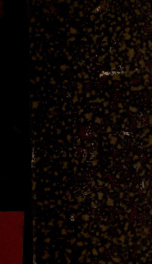
Theophrasti Eresii Opera quae supersunt omnia 3
Series:
Unknown
Year:
Unknown
Raiting:
3.5/5
27
Show more
add to favoritesadd In favorites

Theophrasti Eresii Opera quae supersunt omnia 1
Series:
Unknown
Year:
Unknown
Raiting:
3/5
27
Show more
add to favoritesadd In favorites
Book list

Theophrasti Eresii Opera quae supersunt omnia 2
Series:
Unknown
Year:
Unknown
Raiting:
4/5
27
Show more
add to favoritesadd In favorites

Theophrasti Eresii Opera quae supersunt omnia 3
Series:
Unknown
Year:
Unknown
Raiting:
3.5/5
27
Show more
add to favoritesadd In favorites

Theophrasti Eresii Opera quae supersunt omnia 1
Series:
Unknown
Year:
Unknown
Raiting:
3/5
27
Show more
add to favoritesadd In favorites

The characters of Theophrastus; a translation, with introduction by Charles E. Bennett and William A. Hammond
Series:
Unknown
Year:
Unknown
Raiting:
2.5/5
26
Show more
add to favoritesadd In favorites

The characters of Theophrastus. Edited by J.M. Edmonds and G.E.V. Austen
Series:
Unknown
Year:
Unknown
Raiting:
3.5/5
26
Show more
add to favoritesadd In favorites

Enquiry into plants and minor works on odours and weather signs, with an English translation by Sir Arthur Hort, bart 1
Series:
Unknown
Year:
Unknown
Raiting:
5/5
14 26 45 52
Show more
add to favoritesadd In favorites

The Characters of Theophrastus, newly edited and translated by J.M. Edmonds
Series:
Unknown
Year:
Unknown
Raiting:
5/5
26
Show more
add to favoritesadd In favorites
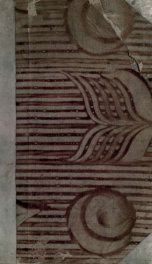
Characteres. Recensuit animadversionibvs illustravit atqve indicem verborvm adiecit Ioh. Frider. Fischerus; accessit commentarivs Isaaci Casavboni
Series:
Unknown
Year:
Unknown
Raiting:
4/5
26
Show more
add to favoritesadd In favorites

The Characters of Theophrastus
Series:
Unknown
Year:
Unknown
Raiting:
3.5/5
Book digitized by Google and uploaded to the Internet Archive by user tpb.
Show more
add to favoritesadd In favorites

I caratteri morali
Series:
Unknown
Year:
Unknown
Raiting:
3.5/5
Book digitized by Google from the library of Harvard University and uploaded to the Internet Archive by user tpb.
Show more
add to favoritesadd In favorites

Enquiry Into Plants and Minor Works on Odours and Weather Signs
Series:
Unknown
Year:
Unknown
Raiting:
3/5
Book digitized by Google and uploaded to the Internet Archive by user tpb.
Show more
add to favoritesadd In favorites

Enquiry Into Plants and Minor Works on Odours and Weather Signs
Series:
Unknown
Year:
Unknown
Raiting:
4.5/5
Book digitized by Google and uploaded to the Internet Archive by user tpb.
Show more
add to favoritesadd In favorites

Enquiry Into Plants and Minor Works on Odours and Weather Signs
Series:
Unknown
Year:
Unknown
Raiting:
3/5
Book digitized by Google and uploaded to the Internet Archive by user tpb.
Show more
add to favoritesadd In favorites

Theophrasti Characteres, Marci Antonini Commentarii, Epicteti Dissertationes ab Arriano literis ... 10
Series:
Unknown
Year:
Unknown
Raiting:
2.5/5
Book digitized by Google from the library of the University of Michigan and uploaded to the Internet Archive by user tpb.
Show more
add to favoritesadd In favorites
What readers are saying
What do you think? Write your own comment on this author!
write a commentif you like theophrastus try:
readers also enjoyed
What readers are saying
What do you think? Write your own comment on this author!
write a commentGenre
if you like theophrastus try:
readers also enjoyed
Do you want to exchange books? It’s EASY!
Get registered and find other users who want to give their favourite books to good hands!
